#california state history
Explore tagged Tumblr posts
Text



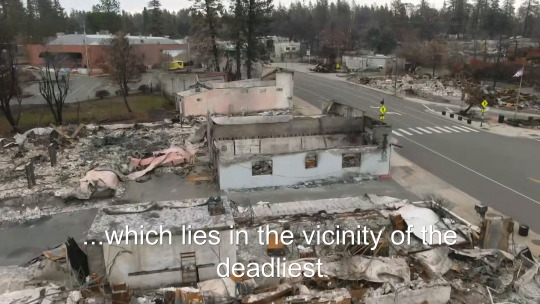

[This trip, we're making a special visit to Chico, California... Which shows that most people do acknowledge a distinction. ...which lies in the vicinity of the deadliest and most destructive wildfire in California state history.]
#s31e03 coming together in cali#guy fieri#guyfieri#diners drive-ins and dives#california state history#special visit#most people#destructive wildfire#trip#chico#distinction#vicinity#deadliest
10 notes
·
View notes
Text

Loaded up and ready to go.
Humboldt State Park, California
1990
#vintage camping#campfire light#california#humboldt state park#family camping#history#camping#hiking#road trips#cycling#1990s
178 notes
·
View notes
Text

Largest religious denomination in the USA by county
Btw this doesn’t show atheism/irreligion, so like in Los Angeles, 60-70% of religious people are Catholic, it’s not that 60-70% of Angelenos are Catholic, just the ones who profess a religion.
#map#maps#cartography#usa#data#americas#geography#religion#catholic#Catholicism#orthodox#christ#christblr#chart#demographics#theology#history#counties#states#California#Texas#Florida#New York#nyc#Mormon#LDS#Mormonism#protestantism#evangelical#evangelicals
776 notes
·
View notes
Photo

Dress
Gilbert Adrian (Los Angeles, California)
c.1947
LACMA (Accession Number: 56.14.3a-b)
#dress#fashion history#vintage fashion#gilbert adrian#1940s#1947#20th century#pink#blue#purple#pastel#cotton#united states#california#lacma
278 notes
·
View notes
Text




The lobby of Convair / General Dynamics plant,
San Diego, California, United States,
Designed by William Leonard Pereira and Charles Luckman in 1958
#art#design#stairwell#stairway#architecture#staircase#stairs#interiors#spiral staircase#lobby#convair#general dynamics plant#san diego#california#united states#mcm#mid century modern#william leonard pereira#charles luckman#style#history#astronautics#kearny mesa
86 notes
·
View notes
Text




Douglas XB-42 Mixmaster (43-50224) parked on the tarmac, likely at the Muroc Army Airfield, California. This was the first of two prototypes ordered by the USAAF.
Date: May 10, 1944
SDASM Archives: 01_00095105_2, 01_00095103_2, 01_00095104_2
National Museum of the United States Air Force: 061020-F-1234S-001
#Douglas XB-42 Mixmaster#Douglas XB-42#XB-42 Mixmaster#XB-42#B-42#Mixmaster#Bomber#Cancelled#United States Army Air Corps#U.S. Army Air Corps#US Army Air Corps#Army Air Corps#Air Corps#USAAC#World War II#World War 2#WWII#WW2#WWII History#History#Military History#Edwards Air Force Base#California#May#1944#my post
107 notes
·
View notes
Text

📍Carolands Château, Hillsborough, California, United States of America 🇺🇸
#dark academia#light academia#classical#academia aesthetic#escapism#academia#books and libraries#classic literature#books#architecture#old#building#exterior#historical#history#travel#place#photography#Carolands Château#Hillsborough#California#USA#united states of america#royal core#cottage core#aesthetics#academic#mood#vibe#tumblr
53 notes
·
View notes
Text
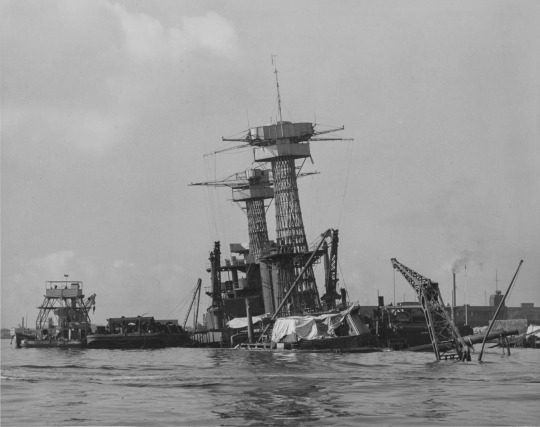
USS California (BB-44) on January 26, 1942. Salvage workers have removed her 14 inch guns to lighten the battleship in preparation to refloat and tow her to the drydock for repairs.
"USS California was struck by two torpedoes and one bomb. Near-miss damage resulted from a second bomb and minor damage was caused by a third. Minor fragmentation damage resulted from bombs at a distance. There was one fire aboard as a result of the bomb hit. About two hours after the start of the attack a surface oil fire completely enveloped the vessel. Finally, a vapor explosion occurred forward just prior to completion of salvage operations. The vessel sank slowly and did not approach the final position in the mud until late Wednesday night or early Thursday morning."
information from her damage report
Digital Archives of Hawai'i: PPFUR-2-15-007
USS California Damage Report: link
#USS CALIFORNIA (BB-44)#USS CALIFORNIA#Tennessee Class#Dreadnought#Battleship#Warship#Ship#United States Navy#U.S. Navy#US Navy#USN#Navy#Pearl Harbor Navy Yard#Pearl Harbor#Hawaii#World War II#World War 2#WWII#WW2#WWII History#History#Military History#January#1942#my post
35 notes
·
View notes
Text

To every student who’s protesting at their college or campus across America: don’t stop standing for what is right and you are the ones who are helping to change America for the better!
☮️🇺🇸☮️
#history#student strike of 1970#united states#student protest#students for gaza#american history#columbia university#university of south florida#usf#university of california#high school#college#democratic history#palestine protest#anti zionisim#kent state university#1970s#protest#democracy#vietnam war#activism#anti war protest#nickys facts
25 notes
·
View notes
Text
Understanding the Southern Perimeter’s Republican Lean: A Multi-Factor Analysis

The political landscape of the United States is often discussed in terms of blue and red states, with certain regions consistently leaning Republican or Democrat. However, the southern perimeter of the continental U.S.—stretching from California to Florida—presents a unique case study. Despite cultural diversity, varying industries, and demographic shifts, this region generally leans Republican. This alignment, which includes border states with Mexico and those along the Gulf Coast, emerges from a complex interplay of geography, economics, historical values, and cultural attitudes.
1. Geographical and Climatic Influences
The southern perimeter is defined by its warmer climates, which attract specific demographics, most notably retirees. States like Florida have become retirement havens, drawing older populations from traditionally Democratic northern regions. This migration brings a demographic that often prioritizes conservative values such as lower taxes, property rights, and fiscal conservatism, aligning well with Republican ideologies. The subtropical to desert-like climate also shapes industries in these states, favoring agriculture, tourism, and energy sectors that lean conservative due to their reliance on limited government intervention and favorable regulatory policies.
Additionally, the shape and layout of these states play a role. California’s extensive north-south reach and diverse climate foster a mix of political ideologies, making it more complex, though its highly populated coastal cities tend toward Democratic dominance. By contrast, Arizona and Texas, with expansive rural and desert regions along the border, amplify conservative values centered on self-reliance and individualism, often associated with frontier mentality.
2. Historical and Cultural Factors
Southern states, including those on the southern perimeter, have a strong cultural legacy of conservatism rooted in a combination of frontier independence, skepticism of federal oversight, and a tradition of states’ rights. This tradition resonates with Republican ideology, which emphasizes limited government, individual liberties, and a cautious approach to social change. While California may stand as an exception due to its urban liberal hubs, the states from Texas through Florida reflect this traditional conservatism that has persisted over decades, reinforced by political institutions and local values.
Texas, in particular, embodies this “frontier spirit.” The state’s long history as a republic, combined with its emphasis on rugged individualism and suspicion of centralized power, aligns with Republican principles. Arizona, with its substantial rural population and similar desert environment, mirrors this mindset. The “frontier mentality” persists in these areas, where local culture values autonomy and self-reliance—traits that naturally dovetail with conservative ideologies.
3. Economics and Industry Patterns
Economic structures in these states contribute heavily to their conservative leanings. Texas, for example, is a major oil producer, while Florida’s economy is driven by tourism and agriculture. These industries often thrive under conservative economic policies, which typically favor deregulation, low taxes, and minimal government interference. Republican economic policies are seen as beneficial by stakeholders in these sectors, making the party an appealing choice for many business owners and workers.
Moreover, certain industries in these states feel the impact of immigration more directly, leading to support for stricter border policies and a more conservative stance on national security. Agriculture and construction in Arizona, Texas, and Florida rely heavily on immigrant labor but also face challenges from undocumented immigration, shaping local attitudes toward Republican policies that prioritize border enforcement and immigration control.
4. Proximity to the Mexican Border and the “Diversity Paradox”
For border states like Texas and Arizona, proximity to Mexico brings border security and immigration issues to the forefront of local politics. This isn’t just about geographical closeness; it’s about the daily reality of cross-border dynamics that influence attitudes toward national security, cultural integration, and economic impacts. The southern perimeter’s conservative alignment is often reinforced by a sense of “us vs. them,” a cultural boundary that shapes perceptions of national identity and sovereignty.
Counterintuitively, the high diversity in these border states does not automatically translate to liberal leanings. Instead, the influx of new populations can sometimes trigger a conservative backlash, as local communities respond to perceived cultural and economic shifts. This “diversity paradox” suggests that in some cases, increasing diversity can actually entrench conservative ideologies as groups seek to preserve traditional values in the face of demographic changes. California and New Mexico differ here, as both have deeply rooted Hispanic and Native American populations that pre-date current immigration concerns, leading to a multicultural identity that integrates rather than reacts to diversity.
5. Rural-Urban Divide and Population Distribution
The rural-urban divide is a significant factor in understanding Republican dominance in the southern perimeter states. Urban centers in Texas (Austin, Houston, and Dallas), Arizona (Phoenix), and Florida (Miami) tend to lean Democratic, but the vast rural areas and smaller towns remain conservative strongholds. Given that these rural and suburban regions often have disproportionate legislative influence due to gerrymandering and districting practices, Republican preferences are amplified politically.
In these rural areas, the appeal of Republican ideology is tied to a distrust of federal intervention and a commitment to traditional social values. The conservative emphasis on “law and order” and the right to bear arms resonates with rural populations who prioritize self-sufficiency and often feel culturally alienated from urban liberalism. This dynamic creates a political landscape where urban and rural values clash, but the rural-dominated districts sustain Republican influence at state and federal levels.
6. Geopolitical Significance and National Policy
Border security, immigration, and national security are not merely abstract political issues in the southern perimeter states; they are local realities. The Republican party’s stance on border control and immigration resonates with communities directly impacted by these policies. For residents in states like Texas and Arizona, issues of border security are personal and immediate, influencing their political alignment. The southern perimeter’s exposure to these cross-border dynamics fuels support for policies that emphasize strict immigration enforcement, contributing to the region’s Republican leanings.
Furthermore, the high visibility of national debates on immigration and security in these states places them in a unique geopolitical position. Residents of the southern perimeter often view federal immigration policies through the lens of local impact, which can heighten conservative stances on enforcement and sovereignty, particularly during times of political polarization on these issues.
The southern perimeter’s Republican alignment, spanning from California to Florida, is a product of interwoven geographical, economic, cultural, and historical factors. From the lure of warm climates drawing conservative-leaning demographics to the economic structures that benefit from conservative policies, each element reinforces the region’s political leanings. The combination of rural influence, frontier mentality, and proximity to the Mexican border creates a unique political identity that sustains Republican dominance.
While California and New Mexico serve as exceptions due to their own unique geographic and cultural compositions, the southern perimeter as a whole demonstrates the impact of physical geography and local demographics on political identity. This analysis underscores how politics in border states cannot be reduced to simple assumptions about diversity or proximity to Mexico; instead, it is the product of complex, localized dynamics that shape conservative values and Republican support across the region.
#south#southern border#souther states#border#southern perimeter#border states#border patrol#republican#conservatives#geography#history#analysis#political science#mexico#california#arizona#texas#new mexico#louisiana#mississippi#alabama#florida#georgia#south carolina#politics#united states#america#north america
7 notes
·
View notes
Text



















The military Alcatraz Citadel became the civilian Alcatraz Federal Penitentiary on October 12, 1933.
#Alcatraz Citadel#Alcatraz Federal Penitentiary#12 October 1933#US history#United States Penitentiary Alcatraz Island#San Francisco#original photography#summer 2017#architecture#California#interior#exterior#West Coast#Pacific Ocean#anniversary#tourist attraction#landmark#garden#travel#vacation#cityscape#USA
7 notes
·
View notes
Text
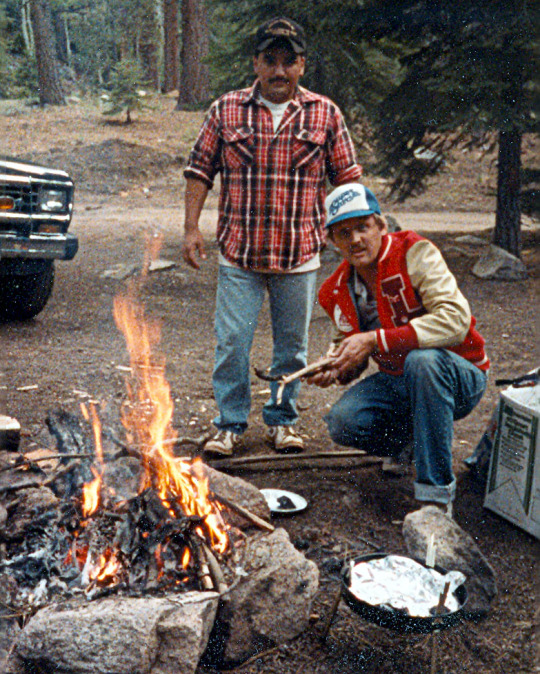
Getting a campfire going to make some lunch.
Donner Memorial State Park, California
1982
#vintage camping#campfire light#truckee#california#donner memorial state park#history#camping#road trips#fishing#1980s
182 notes
·
View notes
Text
Near as I can figure, the parties winning various recent European elections are opposed to ecofascism, fascist speech controls, fascist industrial and agricultural regulations, and do not favor the genocide of the indigenous (of their own countries).
For which they have been denounced as fascists by Marxists, who are an order of magnitude worse than Nazis, let alone fascists proper.
#i guess this is discourse#classical liberalism is worse than fascism and these people are mostly mildly nationalistic social democrats not even liberals#and yes classical liberals are indeed worse than fascism#the vendee genocide and the genocides in california after the anglo takeover and the potato 'famine' are typical classical liberal behavior#also the trail of tears and the terror and the 1798#you know your history classes were in the state schools of a republic right?
10 notes
·
View notes
Note
Are there any books you’d recommend on Jerry Brown?
Jim Newton's 2020 biography, Man of Tomorrow: The Relentless Life of Jerry Brown (BOOK | KINDLE | AUDIO) is excellent. I highly recommend it.
And Miriam Pawel, one of the best chroniclers of California's history and the state's most influential figures (her books on Cesar Chavez and the United Farm Workers movement are must reads), wrote a really good book a few years ago about the Brown political family: The Browns of California: The Family Dynasty that Transformed a State and Shaped a Nation (BOOK | KINDLE | AUDIO).
#Books#History#Books Recommendations#California#California History#Jerry Brown#Governor Brown#Pat Brown#Jim Newton#Man of Tomorrow: The Relentless Life of Jerry Brown#Miriam Pawel#The Browns of California: The Family Dynasty that Transformed a State and Shaped a Nation#The Browns of California#California Governors#Governors#Book Suggestions#Hachette Books#Bloomsbury Publishing
7 notes
·
View notes
Text
Civil War (2024) is a mechanically good film but the commitment to not stoking real world political tensions in a movie about the potential consequences of those tensions leaves a gaping hole in its worldbuilding and reduces its impact to just. a series of melodramatic images of “what if the bad war happened here”. completely declawing any potential impact it could have had for the sake of not being controversial
#literally saw an interview where they were talking about the shot where the lincoln memorial was blown up s#with the host saying jokingly that the message was ‘don’t blow up the lincoln memorial’ bd the director LAUGHED#and that just summarizes the whole movie#like yeah it’s a joke but the commitment to not explaining WHY there was a secession movement and WHY everyone was divided meant it really i#is just a toothless ‘don’t make the country at war 🙂 because then all those scary war crimes we see in other countries would happen here.#wouldn’t it be scary if someone bombed the white house :0’#text✨#like the moment i heard that the main conceit was texas and california teamed up bc the writer/director didn’t want to make the conflict#‘too real’ i knew it would be lackluster. dude you clearly do not understand the cultural divide there.#AND THE FLAG????? BOTH THOSE STATES ARE TOO OBSESSED WITH THIER OWN FLAGS AND HOSTORY AS FORMERLY INDPENDENT REPUBLICA#THEY WOULD NEVER HAVE A SINGLE FLAG let alone one as boring as that. it shows that the dude is not from here#for this kind of political commentary you need to understand the cultural context and history to our politics not just the recent years of#ooooooo political division scary :(#:/ idk man. the character parts were good but the message is nonexistent bc they didn’t want to do the one thing political movies should do
10 notes
·
View notes
Text
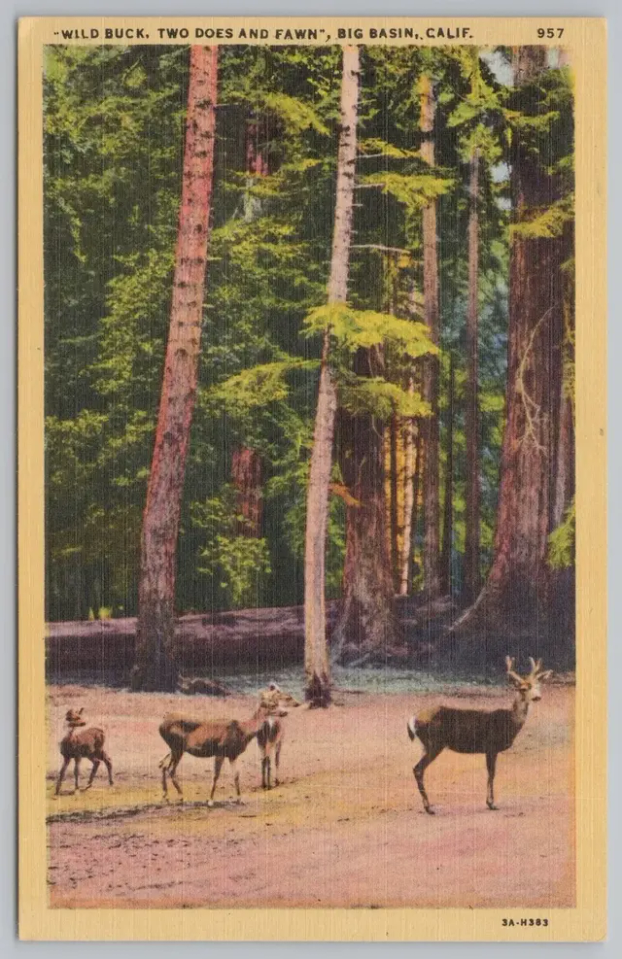
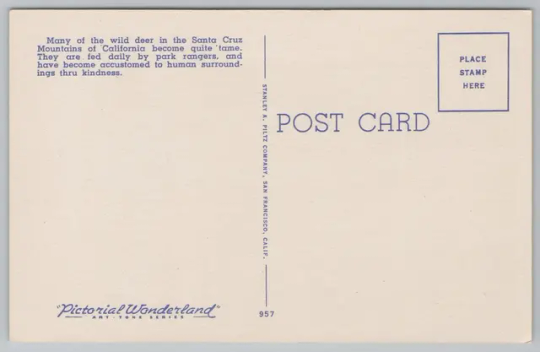
"Wild Buck, Two Does and Fawn", Big Basin, Calif.
Vintage Linen-Type Postcard, Pictorial Wonderland Art-Tone Series; Stanley A. Plitz Company circa. 1930-50s.
(please do not feed the wildlife.)
#California#redwoods#black tailed deer#deer#landscape#vintage art#postcard#lithograph#vintage illustration#big basin#forest#animals#history#california history#state parks#santa cruz#this was on a very weird fashy blog so i found a better image and provided historical context and alt text#hope she cries lol
44 notes
·
View notes